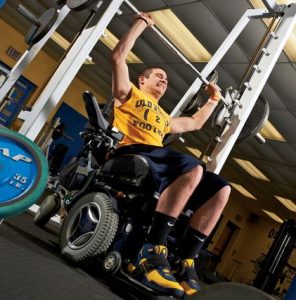People with spinal cord injuries now have a set of exercise guidelines for maintaining heart health to match those offered to the general population decades ago.
 Kathleen Martin Ginis, a researcher at the University of British Columbia’s Okanagan campus, led an international committee that recommends 30 minutes of moderate to vigorous intensity aerobic exercise, three times a week, for people with spinal cord injuries.
Kathleen Martin Ginis, a researcher at the University of British Columbia’s Okanagan campus, led an international committee that recommends 30 minutes of moderate to vigorous intensity aerobic exercise, three times a week, for people with spinal cord injuries.
That’s compared with 150 minutes of cardiovascular exercise every week for others, as recommended by the World Health Organization.
Martin Ginis said the new guidelines are in addition to recommendations she helped come up with in 2011 for people with spinal cord injuries through her work at McMaster University in Hamilton, Ont.
Martin Ginis worked with a team that included participants from Canada, the United Kingdom, the Netherlands, Sweden, Italy and the United States. Their research will be published this week in the journal Spinal Cord.
Besides her own work, the team analyzed 211 studies examining the effects exercise on cardiorespiratory fitness, muscle strength, bone health, body composition and cardiovascular risk factors for people with spinal cord injuries.

Watch Donald Peck Leslie, MD, discuss the importance of a maintaining a healthy lifestyle after SCI.
That population faces significant barriers when it comes to exercise, starting with transportation if they aim to get to a gym, let alone trying to navigate their wheelchairs on sidewalks without ramps, Martin Ginis said in an interview.
Gyms often exclude people with disabilities, but could accommodate them with adaptable equipment and knowledgeable staff, she said.
“If there are ways to get into a facility there are ways to adapt standard exercise equipment for people with spinal cord injuries, at least for strength training,” Martin Ginis said.
“We’ve got lots of anecdotal accounts of people with spinal cord injuries being turned away because the people at the gyms or the recreation centers don’t know what to do with them.”
Jasmin Ma, who collects data at the ICORD gym, a SCI research center in Vancouver, Ontario, as a PhD student and is a personal trainer for people with spinal cord injuries, said some of her clients are surprised to hear they would be able to do aerobic exercise.
“There are a lot of fabulous ways you can do an exercise. It’s just a matter of finding out how you can do it for your specific situation.”
She said people who may not have grip strength, for example, could use grip-resistant gloves or “active hands.”
Leave a Reply